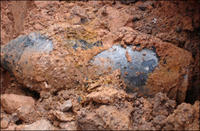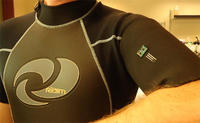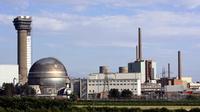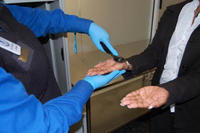-
Old fashioned methods best for detecting IEDs
U.S. troops in Afghanistan and Iraq have resorted to an old method to detect improvised explosive devices (IEDs); using long poles with hooks on the end, troops feel around in the dirt to detect any IEDs
-
-
Crystals developed to detect chemical and nuclear bombs
Researchers are currently exploring the use of crystals to help detect radioactive materials as well as chemical bombs; using a $900,000 grant awarded by the National Nuclear Security Administration Office’s Nonproliferation Research and Development arm, scientists from Fisk University and Wake Forest University are studying the viability of using strontium iodide crystals to screen cargo containers for dangerous explosives
-
-
WWII bombs still plague Germany

For one bomb squad in Germany the Second World War never ended; members of Germany’s War Ordnance Disposal Service are racing against time to locate and safely defuse the hundreds of thousands of unexploded bombs dropped by Allied war planes that still litter the country
-
-
Japan halts shipments of radioactive beef
The Japanese government is coming under fire for only halting shipments of contaminated cattle now, four months after the 11 March earthquake and tsunami that led to the nuclear crisis at the Fukushima Daiichi atomic energy station; authorities recently discovered that 637 cattle had been fed hay contaminated with radioactive cesium and then shipped from farms in northern prefectures including Fukushima
-
-
Sector Report for Monday, 18 July 2011: Detection
This report contains the following stories.
Plus 1 additional story.
-
-
Airport explosive detection machines not up to regulation
A recent Government Accountability Office (GAO) report reveals that airports around the United States have failed to meet federal requirements for explosives detection systems and government regulators have done little to enforce them
-
-
Animal kingdom's alternatives to full-body scanners
A typical full-body scanner costs upward of $150,000, and critics maintain that for this high price-tag we get a detection system which is not fool-proof and which may be risky for our health; they point out that experience in IED diction in Iraq and Afghanistan shows that dogs are superior to scanners in detecting explosives — and that they are much cheaper ($8,500 for a dog plus training) and do not pose any health risk; some researchers say that mice and bees are even better bomb sniffers than dogs
-
-
PositiveID releases groundbreaking new biothreat detector
PositiveID Corporation recently unveiled its new Multiplex BioThreat Assay, which the company says is the first of its kind; according to PostiveID, its latest device is the first commercially available detector that can diagnose up to six bio-threat organisms in the Centers for Disease Control’s category A and B lists in a far shorter time than existing methods
-
-
Troubled radiation screening program gets additional $300 million
The Advanced Spectroscopic Portal (ASP) procurement program has hit another snag in its short-lived, yet troubled life; a recent unreleased Government Accountability Office (GAO) found that DHS plans to spend more than $300 million dollars to purchase several hundred ASPs, radiation detection equipment, that has not been fully tested and may not even work at all
-
-
New radiation detector unveiled, does not rely on helium-3
Princeton Security Technologies, Inc. appears to have a solution to the quickly dwindling helium-3 stockpiles; on Tuesday the company announced that it had developed and delivered the first commercially available nuclear materials detector that does not rely on helium-3
-
-
Japan's prime minister pushes to end nuke program
Japan could soon be following in the footsteps of Germany and shut down its nuclear energy plants; at a televised press conference on Wednesday, Prime Minister Naota Kan pushed to end Japan’s nuclear program; “Japan should aim for a society that does not depend on nuclear energy,” Kan said
-
-
Sensors printed on wetsuits detect explosives, other hazards

UC Sand Diego researcher has successfully printed thick-film electrochemical sensors directly on flexible wetsuit material, paving the way for nano devices to detect underwater explosives or ocean contamination; UCSD has a full U.S. patent pending on the technology, and has begun talks on licensing the system to a Fortune 500 company
-
-
U.K. awards 160 million Pound nuclear decommissioning contracts

The decommissioning of one of U.K. oldest nuclear plants — Sellafield, located close to the village of Seascale on the coast of the Irish Sea in Cumbria, England — has taken a giant step forward thanks to the awarding of three waste retrieval contracts worth more than 160 million Pounds
-
-
TSA could begin searching for explosives hidden inside you

Government intelligence officials are now warning airlines that terrorists could be using surgically implanted explosives to bypass security measures; there is no information regarding a specific plot or threat, but airlines could begin to implement additional screening procedures as the current body scanners cannot effectively detect bombs hidden inside an individual; last year, al Qaeda operatives in Iraq implanted two dogs with explosives, but the dogs died before they could loaded onto a U.S.-bound plane
-
-
Nano detector spots deadly anthrax
The average time of detection of an anthrax attack by current methods — the time required for DNA purification, combined with real-time polymerase chain reaction (PCR) analysis — is sixty minutes; a new, automatic, and portable detector takes just fifteen minutes to analyze a sample suspected of contamination with anthrax
-
More headlines
The long view
Keeping the Lights on with Nuclear Waste: Radiochemistry Transforms Nuclear Waste into Strategic Materials
How UNLV radiochemistry is pioneering the future of energy in the Southwest by salvaging strategic materials from nuclear dumps –and making it safe.
Model Predicts Long-Term Effects of Nuclear Waste on Underground Disposal Systems
The simulations matched results from an underground lab experiment in Switzerland, suggesting modeling could be used to validate the safety of nuclear disposal sites.
